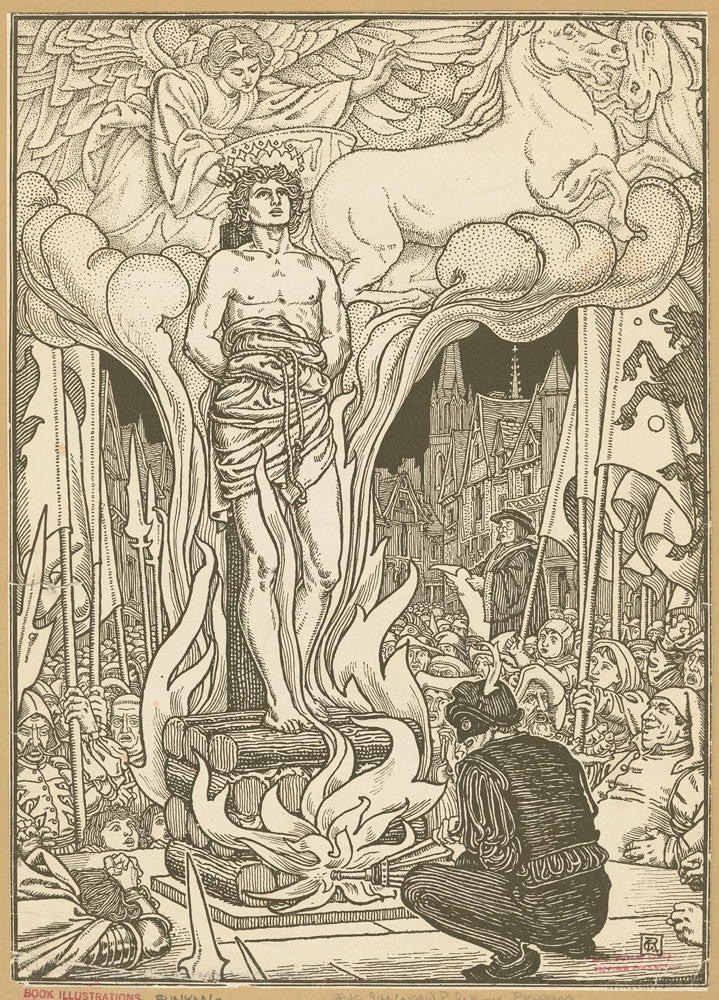Scotch

G. Woolliscroft Rhead:
And last of all, they burned him to ashes at the stake.
Thus came Faithful to his end. (1898)
"I feel wealthy in stories, indeed!"
In my twenties, when I was imprinting on what would become my preferences in liquor, my peers chose everything but the Scotch I selected. The other choices never tasted right to me. Bourbon tasted like Sugar Corn Pops®, and not in any pleasing way. Vodka struck me as better used as a cleaning fluid. Brandy tasted far too sweet. Tequila fully qualified as horrid! Scotch offered exotic flavors with a caché of mystery. I preferred Dewars with a twist of lemon, an order that reliably raised one of the waiter's eyebrows in response. I presumed the eyebrow signaled a highbrow sign that he suspected I must know what I was doing. Honestly, I never knew why I'd chosen that one. It just seemed proper to me. Later, when selecting a Single Malt, I gravitated toward Dewars' offering, Aberfeldy, without once suspecting that fifteen generations of my forebears had lived near Aberfeldy in Lanarkshire, on the Blackwood estate there. Several had been declared Laird of the place, fer cripes sake!
My last installment of this history followed Robert Weir from Ireland to Massachusetts and Oregon through his great-great-granddaughter, my great-great-grandmother, Elizabeth Lovelady Bounds. I mentioned that the Weir family came from the de Vere line, which came to England in 1066 with William The Conqueror. The records get awfully hazy along the ragged edge of prehistory, and not even the most self-interested family historians agree. Suffice it to say that the de Vere family was important enough to William's conquest of England that he rewarded them with relatively vast tracts of land in the lowlands of Scotland. They were duly penitent benefactors of the Abbots of Kelso, now a derelict Abby thanks partly to Henry VIII and his Eight Years' War, his so-called Rough Wooing of Scotland following his break with the Catholic Church.
The Weirs became involved in the Reformation about that time when my twelfth great-grandfather, the Reverend Malcolm "Langshoon" (Some storytellers call him "Longshoes" and some "Longshanks") Weir took up the cause. A man of great wealth, he posed as a peddler in order to have an easy means of contacting secret friends of the Great Reformation. Langshoon carried forbidden Greek Bibles concealed among his belongings. He became close friends with George Wishart, who Papists burned for preaching from the Greek Testament. Wisehart was Malcolm's brother-in-law and brother of his wife, Lady Janet Leslie Wyseart. Today, Wisehart is remembered as a martyr in Protestant circles. "He was carried captive to St. Andrews, where he was tried by a clerical Assembly, found guilty, and condemned as an obstinate heretic. The following day, he was executed at the stake on Castle Green, his persecutor, Cardinal David Beaton or Bethune, looking on the scene from the windows of the castle, where he himself would be assassinated within three months." [Wikipedia]
Malcolm fled to Antwerp to escape Wisehart's fate. He died in Geneva, Switzerland, sometime later. His grandson, John Weir, my tenth great-grandfather, reportedly ran a shipping company out of Antwerp. His home was a refuge for Presbyterian ministers, and one of his ships, the Red Falcon, was condemned for smuggling "political malcontents from the King's justice." He had a son named John Wier, who was a physician. An Encyclopedia (Carnegie Library, Atlanta) sketches a Doctor John Wier, who was adventurous in experimentation and enriched his profession with discoveries. Some Latin notes in the sketch named him Johan Wierus. His son John studied theology in Edinburgh and Iived at the home of Rab Ferguson and wedded Janet, a daughter of this house. They settled in Ireland "on the Derry Road, five leagues from Lough Neagh." [Ten Tribes of Wier in America]
Rev. John Wier, in 1643, was the Presbyterian minister at Dalserf. The next year he and other ministers bore the National League and Covenant to the Soldiers and Protestants in Ulster. On his return his ship was captured by the noted Alistaire Macdonnell. He and others were imprisoned in Mingarie Castle. Here he died. His wife and family survived him. The Reverend Wier had a large family connection and upon expulsion of the Stuarts many of his kin settled in Ulster-Antrim and Tyrone Counties - where they prospered for a hundred years. My forebear, son of the reverend John, brought his family to Massachusetts from Ulster to avoid persecution, and so our story folds back in on itself.
I continue to experience amazement at all the richness contained in seemingly every wrinkle and thread of my Fambly's history. I see, probably unwarrantedly, where my taste in Single Malts might have originated, though I suspect the family after Langshoons might have declined to partake of even the wee-est dram. I revel in the lingering bitter flavors both a dash of a decent Ayreshire Scotch and a spash of history might provide. I feel wealthy in stories, indeed!
©2024 by David A. Schmaltz - all rights reserved


